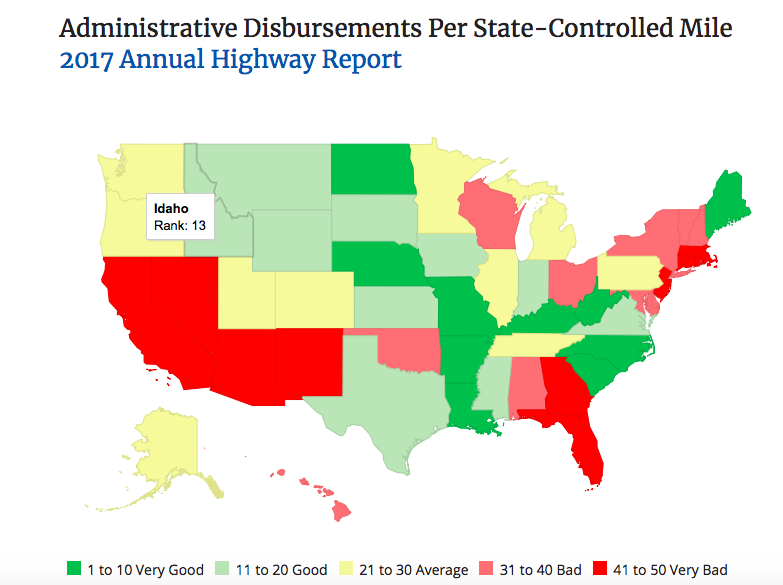The Connecticut Department of Transportation hit back against the Reason Foundation’s annual study of state transportation costs, which showed Connecticut had the highest administrative costs per mile in the country.
In a memo circulated to legislators, the DOT claims “inherent flaws” in Reason’s analysis led to its last-in-the-nation ranking and that, in fact, Connecticut should be ranked 10th in the nation for administrative costs.
But the memo contains a glaring flaw which casts doubt on the DOT’s assertion that Connecticut should be considered one of the most efficient, cost effective states in the nation for administering transportation projects.
Among its criticisms of Reason’s report, is the fact the Reason calculates road miles based on a single lane route, rather than incorporating the number of lanes on a highway. For instance: one mile of a standard neighborhood street is counted the same as one mile of a four lane highway.
The DOT says that when Connecticut’s administrative costs are calculated based on the number of lanes, it moves from 50th in the nation to 10th.
Baruch Feigenbaum, one of the authors of the Reason study, disagrees with the DOT’s findings and says all the data Reason used was self-reported by the states to the Federal Highway Administration.
Feigenbaum says single lane miles are the standard calculation used by the FHWA and adjusting for the number of lanes would do very little to change Connecticut’s ranking.
“It might make Connecticut go from 50th to 49th,” Feigenbaum said. “But I don’t know how they’re claiming they went from 50th to 10th.”
The answer to Feigenbaum’s question may lie in the fact that the DOT only adjusted the mileage calculation methodology for Connecticut and not for any other states, automatically driving up its ranking.
“It appears to me that CTDOT is trying to make itself look more efficient than it is in order to justify increasing funds,” Feigenbaum said. “It is very possible that CTDOT needs additional funds, but the fact that the agency is trying to spin the data is not encouraging.”
The DOT has become the center of a heated political debate since Gov. Dannel Malloy suspended $4 billion in infrastructure projects and proposed increasing the gasoline tax and installing electronic tolls on Connecticut’s highways.
The tolls and gasoline tax would bring an additional $1 billion to the Special Transportation Fund when fully implemented, but the proposal has left the legislature divided and the public bitter.
Reason Foundation’s annual study on state transportation costs was released on the heels of Malloy’s taxes and tolls proposal and generated interest by lawmakers and the public.
Reason’s study found that Connecticut was spending more than $99,000 per mile of road on administrative costs — the highest in the nation.

The DOT’s response to that study was sent out to lawmakers earlier this week and included the DOT’s own calculations, which differ from Reason’s, and used different data than what it reported to the FHWA.
“We don’t cherry pick data or do hidden analysis,” Feigenbaum said. “All of the data is self-reported by the states. FHWA has detailed instructions for how the data is reported. It is not up to the states’ interpretation. So either the state has been correctly reporting data and it ranks 50th in Administrative costs or it has been incorrectly reporting data and it ranks higher.”
In its memo, the DOT excluded fringe benefit costs for employees and a number of other expenditures, claiming these costs are actually expenses for other agencies. Excluding the fringe benefits and other expenditures reduced its administrative costs from $340 million to less than $40 million.
The DOT also said Connecticut is unique in that it owns the rail line between New Haven and New York “with full budget responsibility for the investments in the rail infrastructure, unlike any other state in the country.”
Feigenbaum says that if fringe benefits and rail lines are what the state is using its gasoline tax to pay for, then they will be included in the study’s calculations.
“There are other states that fund rail lines that rank better,” he said. “The fringe benefits are a cost the taxpayers pay, so we’re going to include that.”
The DOT ends the memo by repeating its claim that agency administrative costs should be ranked 10th in the nation, without accounting for the fact they changed the study methodology for only Connecticut.
“With two simple corrections to the data, CTDOT demonstrated that we rank 10th in the nation, and that does not account for other important factors like system complexity, age, multi-modal responsibilities, seasonal impacts on construction and maintenance, regional cost of living and many other factors,” the memo said.
Feigenbaum said the DOT response is typical of what he receives every year. “Every year we get complaints from states that do poorly and praise from states the rank well,” he said, noting that states like Delaware and California have improved their rankings over the years.
“We do note that each state is different, and we don’t expect a state such as Connecticut to rank 1st. However, we do expect it to rank higher than 25th,” Feigenbaum said.

